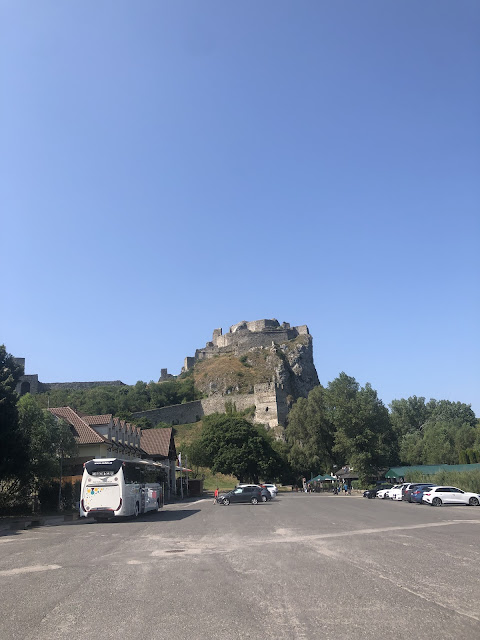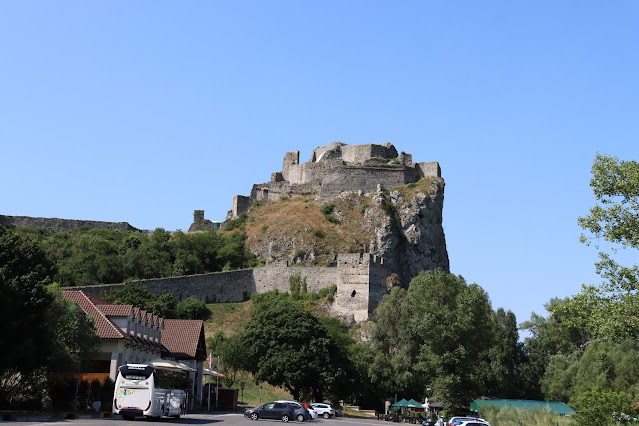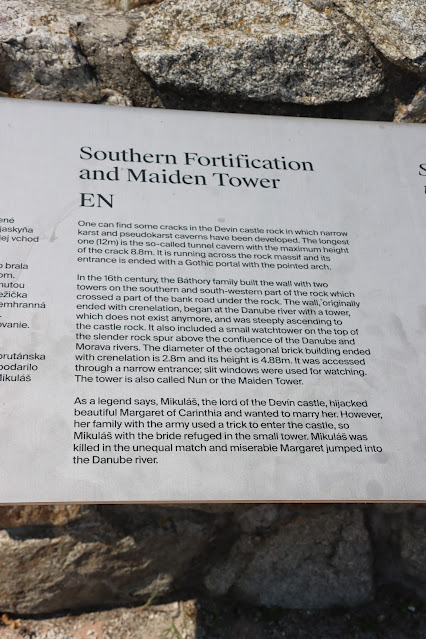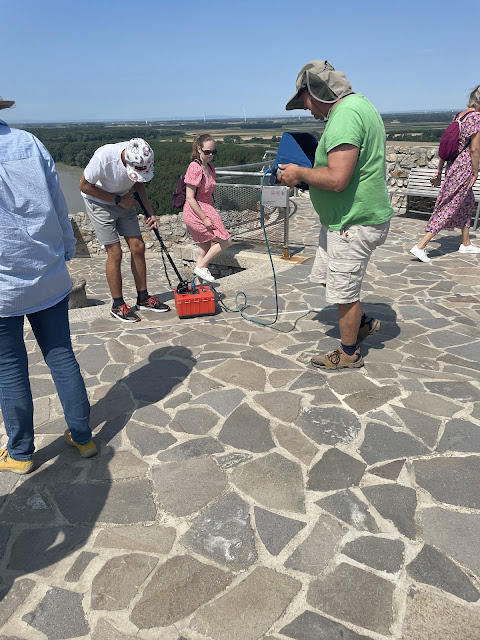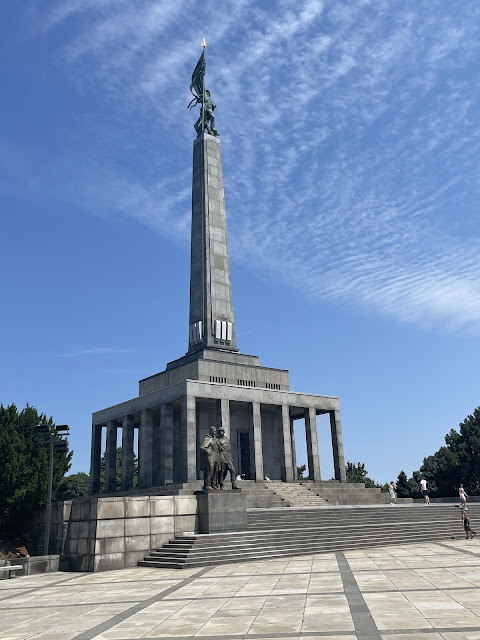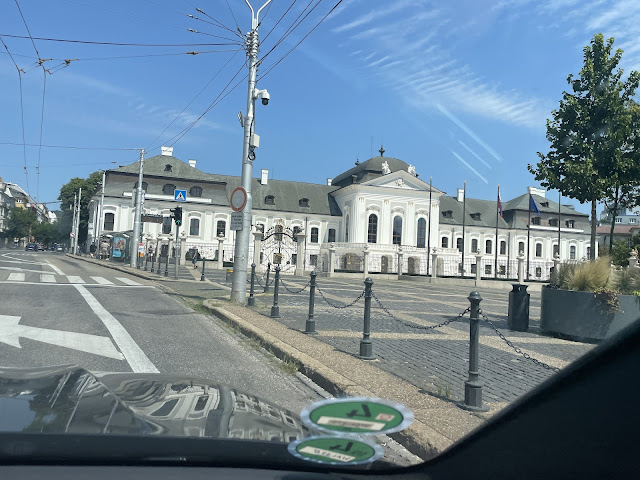Today we left Vienna to head to our next capital city and our next country - Bratislava in the country of Slovakia.
Slovakia, or the Slovak Republic, was another country formed with the collapse of Czechoslovakia. While Czechia (Czech Republic) was formed from the Czech ethnic group, Slovakia (Slovak Republic) was formed from the Slovaks.
The country is bordered by Poland, Ukraine, Hungary, Austria and the Czech Republic. The area was first populated by the Slavic people in the 400-500s. The country was part of several empires over the years, the Avar Khaghanate (500s), Samo's Empire/West Slavic Tribal Union (600s), Principality of Nitra (800s), Principality of Moravia and then Great Moravia, Principality/Kingdom of Hungary (900s).
After World War I, the Austro-Hungarian empire collapsed and Czechoslovakia was formed. In World War II the country was fascist leaning and became a client state of Nazi Germany, with its Jewish population being decimated by Hitler's Final Solution. After the war, Czechoslovakia became a communist state as part of the USSR. In 1993 Slovakia became an independent state with the dissolution of Czechoslovakia.
The name Slovakia, means Land of the Slavs.
The capital city, Bratislava, was originally named Pressburg (until 1919) is unusual in that it is the only capital city to border two sovereign states (Austria and Hungary). It was the legislative capital of the Hungarian Kingdom as well as the site where the Hungarian Kings and Queens were coronated between 1563-1783. The original name of Pressburg (Preßburg) was due to the German influence from the Habsburg monarchy. The name Bratislava comes from a mistranslation of Brezalauspurc (Braslav's Castle) as Bratislav.
We arrived in Bratislava fairly early (as it is a very short drive from Vienna) and so we decided to start with a visit to Hrad Devín (Devín Castle). I wasn't expecting too much, but the castle was pretty awesome. It was a ruin built into a cliff face, 212m high. The first fortification in the site was believed to have been in the bronze and iron age but the Celts and the Romans. The cliff overlooks both the Rivers Danube and Morava, allowing it to control the Amber rode and Danube trade routes. Prior to the fall of the Iron Curtain in 1989, the castle was just inside the Iron Curtain. The castle was open to the public, but just outside it was heavily fortified with watch towers and barbed wire to prevent travel between the Eastern Bloc and the west. The name is believed to have come from the word deiv/doiv meaning watchtower. It is one of the oldest castles in Slovakia and was first mentioned in 864.
We then headed around to the castle gate - built into the bulwark, the tower provided access to the castle from the lower settlement:
 |
| View through the gate |
After walking through some of the ruins and up a shady set of steps we came to another ruin. This was situated away from the the residential areas and dated from the 17th century. It is believed to be a gunpowder store from the 17th century. Tom spent some time making a rock stack:
After we left the gunpowder store, we stopped briefly to watch a barge coming down the Danube, it was quite a busy stretch of water.
We then started up the slope towards the castle ruin:
 |
| Wispy clouds over the ruin |

We entered through the arrow on the left, into the forecourt and then into the middle castle (6). This was an area below the main castle. The Operational Buildings (11) were listed as old farm buildings and only walls remained of them and the Bathoryov Palace.
 |
| Looking towards the Bathoryov Palace (10) from the Operational Buildings (12) |
 |
| Heading up to the forecourt (8) and looking at the walls of the Defensive Bastion (7) |
 |
| Looking up the castle from the Bathorov Palace |
 |
| Looking up at the Gorjanskovcov Palace (9) and Middle Castle (6) |
 |
| Inside the Defensive Bastion |
One of the coolest parts of the ruins was the Maiden Tower:
The next part was always our favourite - stairs and a fair few of them, leading up to the court yard and upper castle:
The view from the top was pretty impressive:
 |
| Looking down over the Operational Buildings and Gorjanskovcov Palace |
 |
| Gorjanskovcov Palace |
 |
| The Neck Moat |
 |
| The Middle Castle |
 |
| The Upper Castle Cistern |
There was a group doing some surveying at the top of the castle, making measurements and taking scans:
After finishing up at the Castle we drove into Bratislava to check out a few of the sights.
The first stop was Slavin, a memorial for the Soviet Soldiers who died in World War II. It was built in 1957 and was unveiled in 1960 on the anniversary of the city's liberation by the Soviet army. Slavin consists of a monument and 323 graves, six of which are mass graves. It contains the bodies of 6,845 Soviet soldiers who died to liberate Bratislava. There was no obvious parks in the area so Kristine waited in the car with the boys while I snapped a few quick photos:
Next we drove towards the UFO lookout, passing a few other buildings on the way. We missed the turn for the lookout and so instead we snapped a few photos and headed back to a lookout overlooking Bratislava Castle.
The first building we passed was Grassalkovich Palace, the Presidential Palace (Grasalkovičov palác). The Palace was built in 1760 and is the home of the Slovakian President:
We then passed the Church of the Assumption of the Mother of God, which was built in the late 1800s. We were trying to find the Blue Church (Church of St Elizabeth) but we missed it and ran out of time to return.
 |
| Church of the Assumption of the Mother of God |
The UFO lookout sits on Most SNP ('Most' being the word for bridge and SNP being Slovenského národného povstania) - i.e. the Bridge of the Slovak National Uprising. Most SNP is a cable-stayed bridge that has a span 303m long over the Danube. At the southern end of the bridge is the UFO Tower - built on the 84.6m bridge pylon, the 'UFO' lookout hosts a restaurant and observation deck.
Our park at the lookout over Bratislava castle was essentially a small dirt road that gave a decent view. The driving and parking in Bratislava had been quite tricky with the big car and hence we hadn't spent a lot of time driving around to look for the Blue Church or for parking to visit the UFO or Slavin. But from this temporary stop we got a good look at the castle.
The castle is a large rectangular white building with a red roof and corner towers. Its elevated location gives it a view into Austria and Hungary. Building was started in the 800s and finished in the 1700s. It lost importance in 1783, with the abolition of the position of Governor of Hungary and the moving of central authority to Buda (now Budapest). In 1809 the castle was attacked by Napoleon's troops and in 1811 the garrisoned soldiers accidentally started a fire that almost destroyed the castle. The ruins were used as barracks during the World Wars, despite some pish to demolish the ruins. In 1946 the ruins were opened for public viewing and full restoration started in 1957.
We then found a park and headed on foot into Bratislava. We got some good views of St Michael's Cathedral. Located near Most SNP, St Michael's is one of the most important churches in Slovakia. It was consecrated in 1452 and has a spire 85m tall. It was originally part of the town's defensive fortifications. Between 1563 and 1830 the church was used for the coronations for the Kingdom of Hungary.
We then headed into the Old Town and to Michalská brána (Michael's Gate). This is the only preserved city gate from the medieval fortifications and one of the oldest buildings in Bratislava. It was build around 1300 and reconstructed in its current baroque style in 1758. There were originally four gates into Bratislava, Laurinc Gate (east), Fishermen's Gate (south), Vydrica Gate (west) and Michael's gate (north).
The original wooden gate was protected with a drawbridge and moat, but was later rebuilt in stone with a portcullis. During coronation of the Hungarian royals, the procession would enter the town through Vydrica Gate, be coronated in St Martin's Cathedral and leave the town via St Michael's Gate.
We then continued on to Stará radnica (Old Town Hall). The Town hall consists of a group of buildings from the 1300s and joined in the 1400s- the City Hall (built in 1370) and three townhouses.
We then stopped for a quick lunch and to visit the most photographed statue in Bratsilava, Cumil the Sewerage worker. It was built in 1997. Cumil means the watcher, so there are two interpretations of the statue, one is that he is a lazy worker having a rest and the other is that he is watching, or peeping, up skirts as people walk past.
We then walked through Old Town and came to the Primacial Palace. Built in the neoclassical style in 1778 it is the seat of the Mayor of Bratislava.
Next was the Church of the Exaltation of the Holy Cross (Chrám Povýšenia vznešeného a životodarného kríža) a newer church from 1860 and home to the Slovak Greek Catholic Church:
We passed two more churches on our way out of the city:
 |
| Cathedral of Saint John of Matha and Saint Felix of Valois |
 |
| Church of St. Stephan of Hungary |
